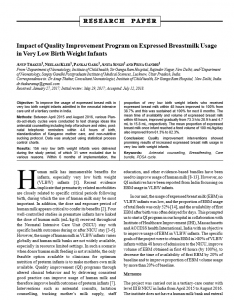
Human milk has immunerable benefits for infants, especially very low birth weight (VLBW) infants. Recent evidence implicate that prematurity related morbidities are closely related to specific critical periods following birth, during which the use of human milk may be most important. In addition, the dose and exposure period of human milk appears critical to confer its benefits. Four well-controlled studies in premature infants have linked the dose of human milk (mL/kg/d) received throughout the Neonatal Intensive Care Unit (NICU) stay with specific health outcomes during or after NICU stay. However, the usage of human milk in VLBW infants varies globally and human milk banks are not widely available, especially in resource limited settings. In such a scenario when donor human milk feeding is not available, the only feasible option available to clinicians for optimum nutrition of preterm infants is to make mothers own milk available. Quality improvement (QI) programs through altered clinical behavior and by delivering consistent good practice can improve usage of human milk and therefore improve health outcomes of preterm infants. Interventions such as antenatal consults, lactation counselling, tracking mother’s milk supply, staff education, and other evidence-based bundles have been used to improve usage of human milk. However, no QI initiatives have been reported from India focussing on EBM usage in VLBW infants.
In our unit, the usage of expressed breast milk (EBM) in VLBW infants was low, and the proportion of EBM usage of total feeds was only 52%, and the availability of first EBM after birth was often delayed for days. This prompted us to start a QI program in our hospital in collaboration with Institute of Healthcare Improvement (IHI), Massachusetts and ACCESS health International, India with an objective to improve usage of EBM in VLBW infants. The specific goals of the project were to obtain EBM in >80% of VLBW infants within 48 hours of admission to the NICU, improve volume of EBM obtained in first 48 hours (by 100%), to decrease the time of availability of first EBM by 20% of baseline and to improve proportion of EBM volume usage by more than 20% of baseline.
—
This special issue of Indian Pediatrics (September 2018; Volume 55: Number 9) highlights mechanisms that can support health care providers in using various quality improvement (QI) approaches and showcases some of the improvement projects undertaken in India by different teams.
The USAID ASSIST Project started working in India in September 2013; initially working directly with districts and facilities to help them learn how to use QI approaches to save lives. This work went well and the staff in these facilities were able to reduce perinatal mortality by 15% over 18 months. During this time, we met great partners from important organizations and institutions across India.
These institutions are now leading a growing movement to help more people apply QI methods to deliver care that prevents harm, improves outcomes, and meets the needs of the people receiving it through their own networks using domestic funding; continuing these lifesaving efforts after ASSIST technical support has ended.
The supplement shows important results of the ongoing QI work in these networks and shows how domestic QI networks, earlier supported by ASSIST, are now independently supporting and spreading the use of QI methods to provide better care.